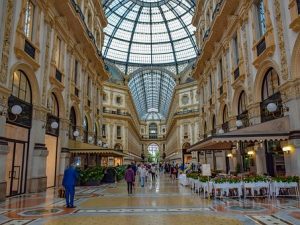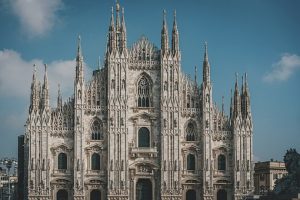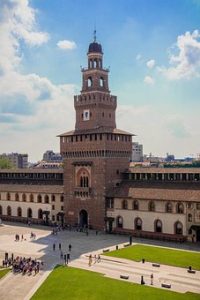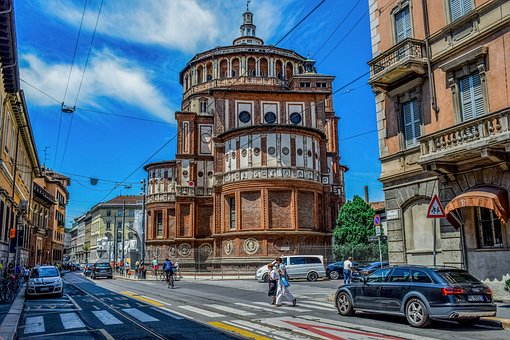ITALY - HISTORY, ART, CULTURE-bilingual almanac
ITALIA - STORIA, ARTE, CULTURE - almanacco bilingue
MILAN – MILAN
Milan was founded by Celtic tribes around 600 BC. When the Romans conquered the city, they renamed it Mediolano - the land in the middle. Thanks to its strategic location in the middle of the fertile valley of the Po River, the city quickly became an important commercial center in the Roman Empire. Today, Milan is the second largest city in Italy. Almost everything revolves around the textile industry. The most famous designers and fashion houses are located there. The area around Via Montenapoleone and Via Della Spiga is the heart of the fashion industry and home to many brand stores. The historic center is home to many of the city's attractions, including the Duomo and La Scala Opera House. Navali, next to the canals, is another intriguing neighborhood with nightlife and the Brera Art Academy.
 Milan was founded by the Celtic tribes around 600 BC When the Romans conquered the city, they conquered Mediolano – the land in the middle. Thanks to its strategic position at the center of the fertile valley of the river Po, the city quickly became an important commercial center of the Roman Empire. Today Milan is the second largest city in Italy. Quasi tutto ruota attorno all'industria tessile. Qui si trovano gli stylisti e le case di moda più famosi. The area intorno a Via Montenapoleone and Via Della Spiga is the heart of the fashion industry and hosts many brand shops. Il centro storico hosts many attractions of the city, including the Duomo and the Teatro alla Scala. Navali, vicino ai Navigli, is another intriguing neighborhood with nightlife and the Accademia d'Arte di Brera.
Milan was founded by the Celtic tribes around 600 BC When the Romans conquered the city, they conquered Mediolano – the land in the middle. Thanks to its strategic position at the center of the fertile valley of the river Po, the city quickly became an important commercial center of the Roman Empire. Today Milan is the second largest city in Italy. Quasi tutto ruota attorno all'industria tessile. Qui si trovano gli stylisti e le case di moda più famosi. The area intorno a Via Montenapoleone and Via Della Spiga is the heart of the fashion industry and hosts many brand shops. Il centro storico hosts many attractions of the city, including the Duomo and the Teatro alla Scala. Navali, vicino ai Navigli, is another intriguing neighborhood with nightlife and the Accademia d'Arte di Brera.
LANDMARKS IN MILAN – DA VEDERE A MILANO
Duomo (Il Duomo)
 The cathedral is a symbol of Milan. Its construction began in 1386 and was not completed for 500 years. It is a masterpiece of the late Gothic style. The fact that this style is not found anywhere else in Italy makes the cathedral even more interesting.
The cathedral is a symbol of Milan. Its construction began in 1386 and was not completed for 500 years. It is a masterpiece of the late Gothic style. The fact that this style is not found anywhere else in Italy makes the cathedral even more interesting.
The Duomo is a symbol of Milan. Its construction began in 1386 and was not completed for 500 years. È un capolavoro dello stile tardogotico. Il facto che questo stile non si trovi da nessun'altra parte in Italia makes the cathedral even more interesting.
Cenacolo Vinciano
It is the home of the most famous work of art - Leonardo da Vinci's Last Supper. It's not usually possible to just go and see her. A good way to avoid the line is to make an appointment.
È la casa dell'opera d'arte più famosa: l'Ultima Cena di Leonardo da Vinci. Di solito non è possibile andare a trovarla. A good way to avoid the queue is to fix an appointment.
Sforza Castle (Castello Sforzesco)
Built in 1368, over the centuries it was used both as a fortress and as a mansion.
Costruita nel 1368, nel corso dei secoli fu utilizzada sia come fortezza che come dimora signorile.
Pinakothek di Brera (Pinacoteca di Brera)
Milan doesn't have as many artistic treasures as Venice or Florence, but it's not far behind. The city museum displays works by Mantena, Giovanni Bellini, Bramante and Caravaggio, as well as many others.
Milan doesn't have many artistic treasures like Venice or Firenze, but it doesn't matter. Il museo cittadino espones opere di Mantena, Giovanni Bellini, Bramante e Caravaggio, oltre a molti altri.
Triennale (Triennale)
An art space, home to the Milan Triennale and a number of other exhibitions.
Uno spazio d'arte, sede della Triennale di Milano e di numerouse altre mostre.
Triennale Boviza (Triennale Bovisa)
This new cultural space was recently opened near Boviza station. It presents exhibitions of contemporary art, there is also a bookstore.
This new cultural space has recently been opened near the Boviza station. Presenta mostre di arte contemporanea, c'è anche una libreria.
© 2023 Iliana Dechkova

